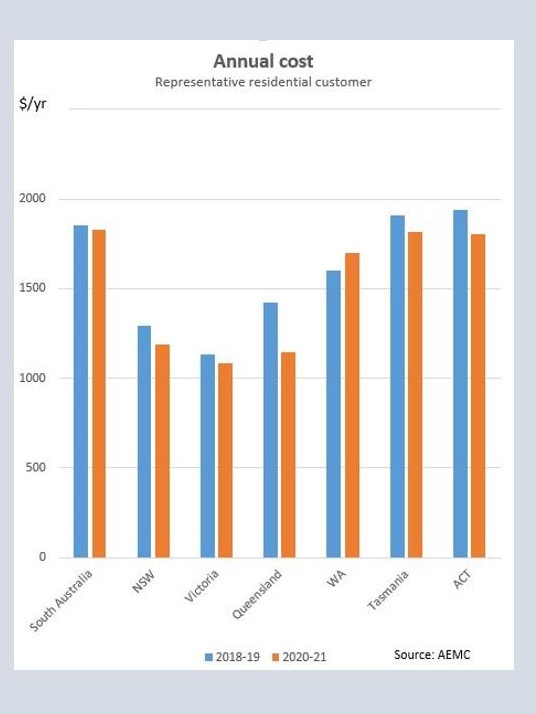Growth of renewable energy will lessen SA power bills, but we’ll remain the most expensive per unit of electricity
We’re set to save some money on energy bills in the next three years, but SA will retain the unenviable title of most expensive grid supply.

SA News
Don't miss out on the headlines from SA News. Followed categories will be added to My News.
Growth in renewables will drive down power bills over the next three years but SA will benefit less than most, despite being a green energy leader.
An authoritative national report from the Australian Energy Market Commission (AEMC) says SA households will see a modest fall of $28 a year by 2022, compared to an average national reduction of nearly $100 a year.
The Commission’s annual projections report is relied on by governments, the Reserve Bank and the International Energy Agency.
It says in SA, generation costs are falling substantially because of wind farms and solar.
That will save households $84 a year as more green projects come online. Environmental scheme costs also will fall by $16.
But higher retailer margins will add $39, though the report does not explain why.
And the combined rise in transmission, distribution and metering of $33 will further erode any gains. It means SA will retain the unwanted title of having the most expensive grid supply per unit of electricity. According to the report, most of that $33 rise is due to transmission costs.


Transmission company ElectraNet has been given the go ahead to invest $240 million in replacing the main transmission line in the Eyre Peninsula, and to spend $166 million on machines called synchronous condensers, which act as shock absorbers to fluctuations in the power grid.
ElectraNet argues the investments will actually result in overall small savings to consumers, but the AEMC projects small increases in the short term.
The costs of generation and environmental schemes are falling across the national electricity market, AEMC chair John Pierce said.
“More supply puts downward pressure on prices,” he said.
“But it’s important to note that over a decade of analysis we have seen trends change sharply in response to factors such as sudden generator closures and implementation of new policies.
“As such, all price projections should be seen as just that, projections.”

Previous projections by the AEMC have mostly been correct except in cases such as the sudden closure of the 1600MW Hazelwood coal plant in Victoria.
Now, there are 2338MW of solar, 2566MW of wind and 210MW of gas-fired generation projects on the nation’s development radar, the report says.
“Understanding the drivers can help to identify appropriate policies that enable the ongoing supply of reliable, secure energy at the best price to consumers during this time of transition (from a few large generators to scattered smaller power sources),” the report said.
For SA, the report identifies significant downward pressure on price – an $84 decrease – as more renewable energy projects come on line.
Environmental scheme costs also will fall (down $16).
However, increases in retailer’s margins (up $39) and in transmission, distribution and metering (up $33) will wipe out most of the decrease.
SA households will only be $28/year better off in three years’ time – with the annual bill falling to $1826.
Federal Energy and Emissions Reduction Minister Angus Taylor said the AEMC projections “complement a number of recent reports showing prices have started to turn the corner”.
This included the Australian Bureau of Statistics recording three consecutive quarters of electricity price falls.
“But there is more to be done,” Mr Taylor said.
The report cautions that prices it lists are based on a representative household, essentially the average-size household consuming an average quantity of energy a year.
Representative customers are different for each state and actual bills paid by individual households will vary considerably depending on their circumstances.
To calculate prices, the AEMC takes the lowest market offers, weighted according to market share of retailers.
The median of market offers is higher and the default market offer which applies to fewer than 10 per cent of consumers who haven’t shopped around is higher still – in SA these customers are paying about $250/year more for the same quantity of energy.
